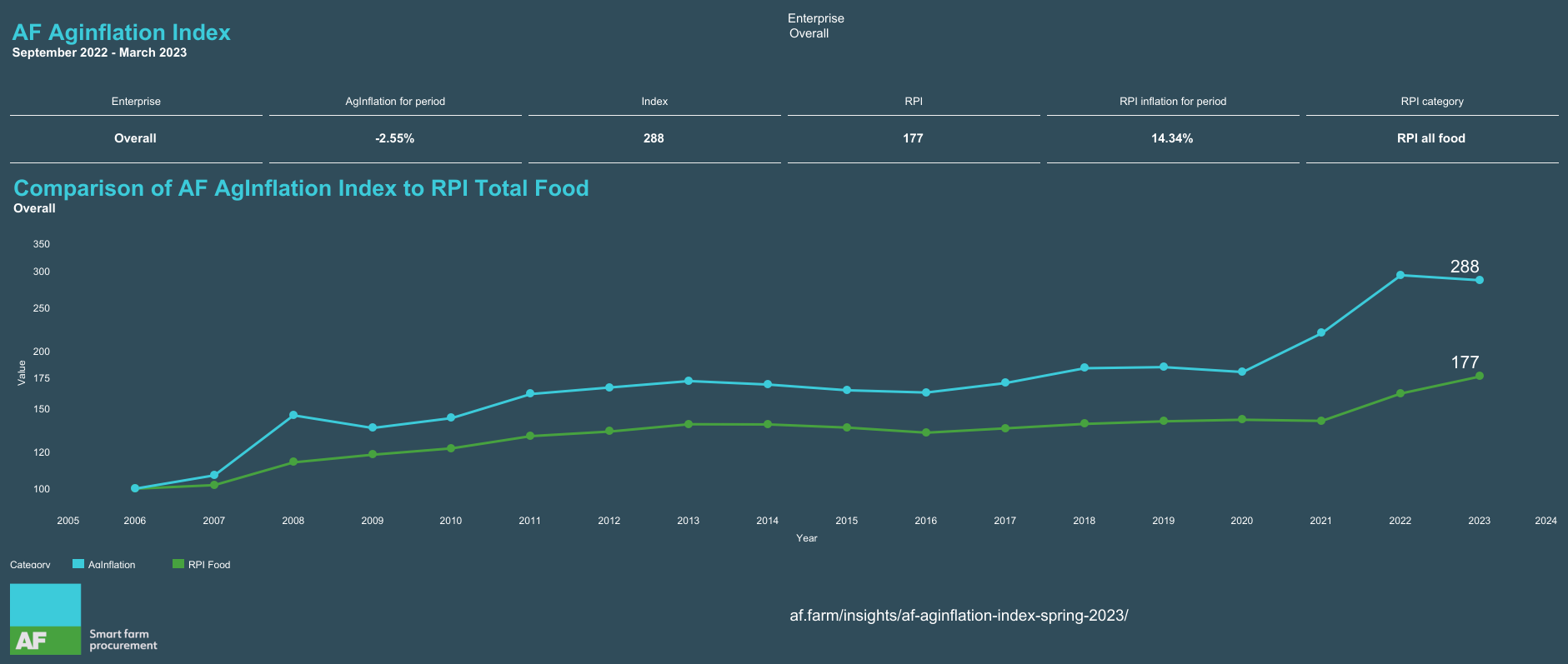News
AF Interim Agricultural Inflation Index records a downward dip after years of spiralling costs
27 April 2023
AF’s latest and Interim Aginflation Index has revealed that, for the first time in over three years, the average cost of farming inputs has decreased, falling by 3.17% in the six months to the end of March 2023.
This headline downward overall trend, in the sixteenth year of monitoring prices, is welcome. However, analysis by AF shows the contrasting trends that farm business owners are having to cope with.
Two out of the nine categories of inputs saw double digit negative inflation with fertiliser and fuel seeing greatest reductions at 30% and 23% respectively. Three other categories of machinery, contract hire and animal feed and medicine show slightly falling costs by 2.3%, 1.9% and 1.7% respectively.
However, three important types of farm inputs continue their upward inflation with cost of chemicals up almost 13%, rent and other business operating expenses up by over 7% and labour up 6.6%.
The AF summary of Aginflation by major specialist farm enterprise also shows contrasting trends.
While some are enjoying negative inflation in the costs of their inputs, dairy (-4.84%), potatoes (-3.71%) and beef and lamb (-2.68%) others are seeing the opposite.
Sugar beet production costs are up again by 4.75% as are inputs for cereals and oilseed rape, but only by 0.56%.
Over the same six-month period the total food Retail Price Index has risen by 14.3%.
This average increase in prices for a basket of key foodstuffs is derived from greatly different values for particular household food essentials. Milk shows the biggest price increase (44%), with bread and margarine next (27%) followed by beef and lamb meat (16.3%), potatoes (12.2%) and sugar (7%).
Whilst food inflation continues to follow the sharp upward trajectory of recent Aginflation, it is still not at a rate to supply prices to farmers that cover their increased costs.
The AF Aginflation Index is respected as a useful tool for businesses to continually review their expenditure and procurement partners.
“History shows that some commodity prices can fall sharply after above average rises. However not all prices have relaxed. What I hear and see is farmers keeping closer eye than ever on costs and the ways they can reduce expenditure where they can.
The reality of living with high levels of Aginflation for three years has prompted many changes on farm.”
AF Head of Member Services Louis Clabburn
“Supply chain volatility and uncertainty in crop protection products are a big a threat to Members as well as price inflation, this Spring especially.
AF crop input expertise and experience challenges the norm. We advise not just what to buy from a full product portfolio for financial and environmental efficiency but when for the best point of value. This value is not only the price, but also availability of the product.”
AF Crop Protection Procurement Manager Lee Oxborough
“Last year we saw significant increases in feed prices. Already this year we have seen substantial reductions in feed cereals. However, proteins such as soya remain expensive. This all means that compound and blended feed prices haven’t fallen as much as wheat markets may suggest. Straights-buying livestock farmers may well want to consider booking their wheat now while waiting and hoping for proteins to fall.
Within machinery procurement we have seen some significant downward trends. Many manufacturers have slashed prices dramatically as parts become more readily available and to stimulate spend with customers: a trend I expect to continue as supply constraints ease and competition increases.”
AF Head of Livestock Inputs and General Kristian Dunham
“The dip in Aginflation is very good news but it’s too variable across different types of farm business to give much cause for relief. The gap between the cost of production and the value of sales is still too wide and too variable to be sustainable. The significant drop in fertiliser prices is, of course, welcome but many farmers bought their fertiliser when prices were still sky high and now output values are falling, so this could be a very difficult harvest for farmers.
It’s alarming that crop protection prices are continuing to rise, and we are encouraging our Members to look beyond brand names and focus on active ingredients. We’ve been tracking Aginflation for 16 years and we’ve seen this lag before. If previous patterns continue, we should see these prices begin to ease next year as the reduced cost of production begins to impact.”
AF Chief Executive David Horton-Fawkes